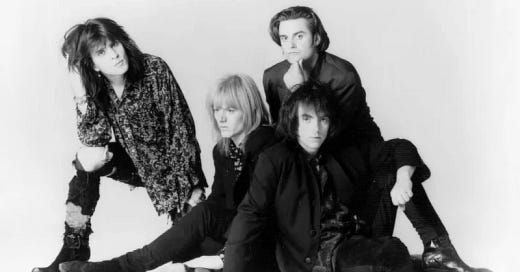Gene Loves Jezebel | History of the Band
From Goth Beginnings to Split Identities: Navigating the 90s Alternative Scene with Resilience and Reinvention
Gene Loves Jezebel, a band with a name as enigmatic as its sound, was formed in 1980 in the UK by twin brothers Michael and Jay Aston. Initially rooted in the post-punk and gothic rock scenes, the band gained traction in the early ‘80s with a dark, atmospheric sound that resonated with the burgeoning goth subculture. The original lineup, besides the Aston brothers, included Ian Hudson on guitar, Stephen Marshall on bass, and drummer Chris Bell. Early influences ranged from glam rock to the dark allure of bands like Bauhaus and The Sisters of Mercy. The band’s first few years were marked by a string of cult-favorite releases, but it was in the 1990s that their journey took a series of unpredictable turns.
Vasilii suggested this artist for a future Dig Me Out podcast episode. Each month, our Patrons are presented with a selection of albums suggested by listeners and asked to vote for their favorite.
By the time the 1990s rolled around, Gene Loves Jezebel had already evolved from their gothic rock roots into a more commercially viable sound, leaning towards alternative rock with a touch of glam. This shift in style was partly driven by the changing landscape of popular music and the band’s desire to remain relevant in an increasingly crowded scene. Their music in the ’90s was characterized by a blend of melodic hooks, polished production, and a certain flamboyance that set them apart from their darker peers.
The band’s musical evolution during this decade was also marked by internal strife, particularly between the Aston brothers. This tension led to the eventual split of the band into two separate entities—one fronted by Jay Aston and the other by Michael Aston, each claiming the Gene Loves Jezebel name. This schism not only confused fans but also divided their discography into two distinct bodies of work, each reflecting the brothers’ differing artistic visions.
Discography and Notable 90s Albums
“Kiss of Life” (1990): Released on Beggars Banquet, this album marked the band’s first significant foray into the 1990s. “Kiss of Life” showcased a more polished, radio-friendly sound, with tracks like “Jealous” becoming a hit on alternative radio and MTV. The album’s production, handled by Peter Walsh, known for his work with Simple Minds and Scott Walker, emphasized a slicker, more mainstream approach. Despite its accessibility, the album retained the band’s signature drama and theatricality, earning them a new wave of fans.
“Heavenly Bodies” (1993): By the time “Heavenly Bodies” was released, the cracks within the band were beginning to show. This album, released under Michael Aston’s version of the band after the split, leaned heavily into a darker, more introspective sound. The production was less polished compared to “Kiss of Life,” and the music had a raw, almost melancholic edge. Tracks like “Motion of Love” and “Josephina” were standouts, blending goth rock’s moody atmospheres with alternative rock’s melodic sensibilities.
“The House of Dolls” Reissue (1993): Although originally released in 1987, “The House of Dolls” was reissued in the ‘90s and continued to influence the band’s evolving fan base. The reissue included additional tracks and was remastered for a new audience, introducing some of their earlier work to those who had only discovered them in the ‘90s. The album’s blend of glam and goth provided a bridge between their earlier, darker material and their more commercial ’90s sound.
Gene Loves Jezebel’s work in the 1990s received mixed reviews. “Kiss of Life” was generally well-received, with critics appreciating the band’s ability to craft catchy, memorable songs. Publications like AllMusic noted the album’s “infectious energy” and “hook-laden tracks,” while others critiqued it for being too polished and losing some of the rawness that characterized their earlier work. “Heavenly Bodies,” on the other hand, garnered less enthusiasm, with critics often highlighting the band’s internal struggles as being reflected in the album’s disjointed sound.
However, despite the critical ups and downs, the band maintained a loyal fan base, many of whom appreciated their ability to evolve while still retaining the core elements of their sound.
Influence and Legacy
Gene Loves Jezebel’s influence during the 1990s might not have been as pronounced as in their earlier years, but their impact on the gothic and alternative rock scenes remained significant. The band’s unique blend of goth, glam, and alternative rock continued to inspire younger bands, particularly those who appreciated their flair for the dramatic and their ability to fuse dark themes with pop sensibilities.
The split between the Aston brothers led to a fractured legacy, with both versions of the band touring and releasing new material throughout the decade and beyond. Jay Aston’s version of the band leaned more towards the melodic and accessible side, while Michael Aston’s incarnation of Gene Loves Jezebel remained closer to their goth roots. This division only added to the band’s mystique, making their story one of the more intriguing narratives in the ’90s alternative rock scene.
Gene Loves Jezebel’s journey through the 1990s was one of transformation, conflict, and persistence. Despite the challenges they faced, including the fracturing of the band and the shifting musical landscape, they managed to carve out a unique space for themselves. Their discography from this era, though often overlooked, offers a fascinating glimpse into the evolving sound of alternative rock during a time of significant change.
While they may not have dominated the charts or defined the decade, Gene Loves Jezebel’s 1990s output is a vital piece of the puzzle that makes up the larger story of 90s music. Their ability to adapt, survive internal strife, and continue making music that resonated with their fans is a testament to their enduring appeal. For those willing to dig deeper, their work from this era offers rich rewards and a deeper understanding of a band that refused to be easily categorized.





